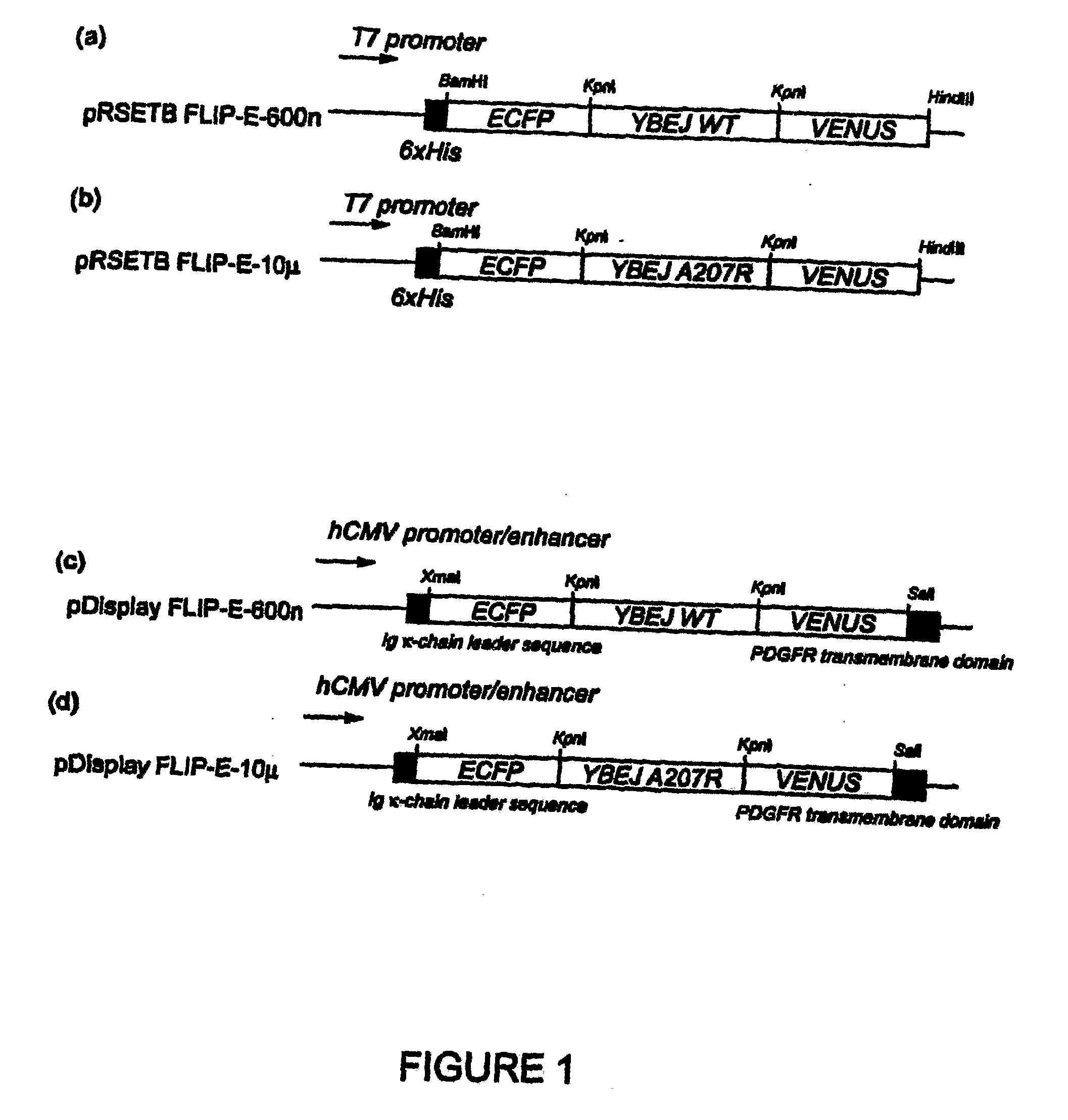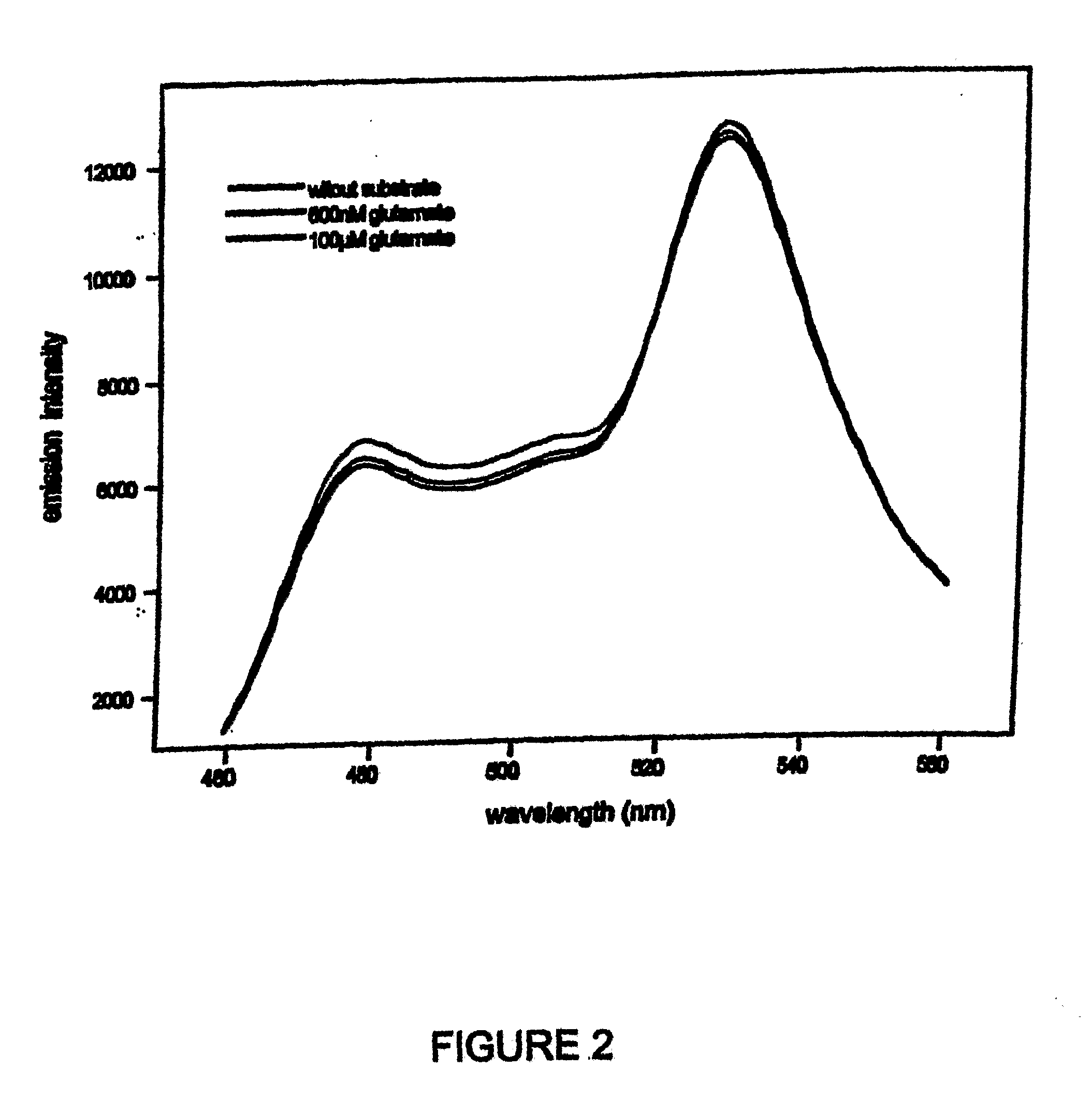Development of sensitive fret sensors and methods of using the same
a fret sensor and sensitive technology, applied in the field of biosensors, can solve the problems of poor spatial resolution, no currently available technology, no cellular resolution, etc., and achieve the effect of increasing rigidity
- Summary
- Abstract
- Description
- Claims
- Application Information
AI Technical Summary
Benefits of technology
Problems solved by technology
Method used
Image
Examples
example 1
Construction of Nucleic Acids and Vectors
[0085]A truncated glutamate-aspartate binding protein sequence (SEQ ID No. 4), encoding mature protein without signal peptide, was amplified by PCR using E. coli K12 genomic DNA as a template. The primers used were 5′-ggtaccggaggcgccgcaggcagcacgctggacaaaatc-3′ (SEQ ID No. 5) and 5′-accggtaccggcgccgttcagtgccttgtcattcggttc-3′ (SEQ ID No. 6). The PCR fragment was cloned into the KpnI site of digested FLIPma1-25μ (Fehr et al. 2002) in pRSET vector (Invitrogen), exchanging the maltose binding protein sequence with the YbeJ sequence. The resulting plasmid was named pRSET-FLIP-E-600n (SEQ ID NO: 9).
[0086]To improve the pH and chloride tolerance and maturation of the sensor protein, the fragment containing the enhanced YFP (EYFP, CLONTECH) sequence in pRSET-FLIP-E-600n was replaced with the coding sequence of Venus, a variant of YFP with improved pH tolerance and maturation time (Nagai, T., Ibata, K., Park, E. S., Kubota, M., Mikoshiba, K., and Miyaw...
example 2
In Vitro Characterization of FLIP-E Nanosensors
[0088]A DNA fragment encoding the mature YBEJ protein was fused to ECFP and the Venus sequence at the N- and C-termini, respectively (FIG. 1). Emission spectra and substrate titration curves were obtained by using monochromator microplate reader Safire (Tecan, Austria). Excitation filter was 433±12 nm, emission filters for CFP and YFP emission were 485±12, 528±12 nm, respectively. All analyses were done in 20 mM sodium phosphate buffer, pH 7.0.
[0089]Addition of glutamate resulted in an increase in CFP emission and a decrease in YFP emission, suggesting that binding of glutamate to YBEJ results in a conformational change of the chimeric protein potentially due to a relative change in the orientation of the dipoles of the fluorophores (FIG. 2). Since CFP and YFP moieties are assumed to be attached to the same lobe, we speculate that glutamate binding causes the change in dipole-dipole angle of two fluorophores. Interestingly, the ratio an...
example 3
In Vivo Characterization of FLIP-E
[0091]For the in vivo characterization of FLIP-E nanosensors, FLIPE-600n and FLIPE-10μ were cloned into the mammalian expression vector pDisplay (Invitrogen, USA). The pDisplay vector carries a leader sequence which directs the protein to the secretory pathway, and the transmembrane domain which anchors the protein to the plasma membrane, displaying the protein on the extracellular face. Rat hippocampal cells and PC12 cells were transfected with pDisplay FLIPE-600n (SEQ ID NO: 11) and −10μ (SEQ ID NO: 12) constructs. FRET was imaged 24-48 hours after transfection on a fluorescent microscope (DM IRE2, Leica) with a cooled CoolSnap HQ digital camera (Photometrics). Dual emission intensity ratios were simultaneously recorded following excitation at 436 nm and splitting CFP and Venus emission by DualView with the OI-5-EM filter set (Optical Insights) and Metafluor 6.1r1 software (Universal Imaging).
[0092]The expression of FLIP-E was observed on the plas...
PUM
| Property | Measurement | Unit |
|---|---|---|
| pH | aaaaa | aaaaa |
| pH | aaaaa | aaaaa |
| pH | aaaaa | aaaaa |
Abstract
Description
Claims
Application Information
 Login to View More
Login to View More - R&D
- Intellectual Property
- Life Sciences
- Materials
- Tech Scout
- Unparalleled Data Quality
- Higher Quality Content
- 60% Fewer Hallucinations
Browse by: Latest US Patents, China's latest patents, Technical Efficacy Thesaurus, Application Domain, Technology Topic, Popular Technical Reports.
© 2025 PatSnap. All rights reserved.Legal|Privacy policy|Modern Slavery Act Transparency Statement|Sitemap|About US| Contact US: help@patsnap.com



